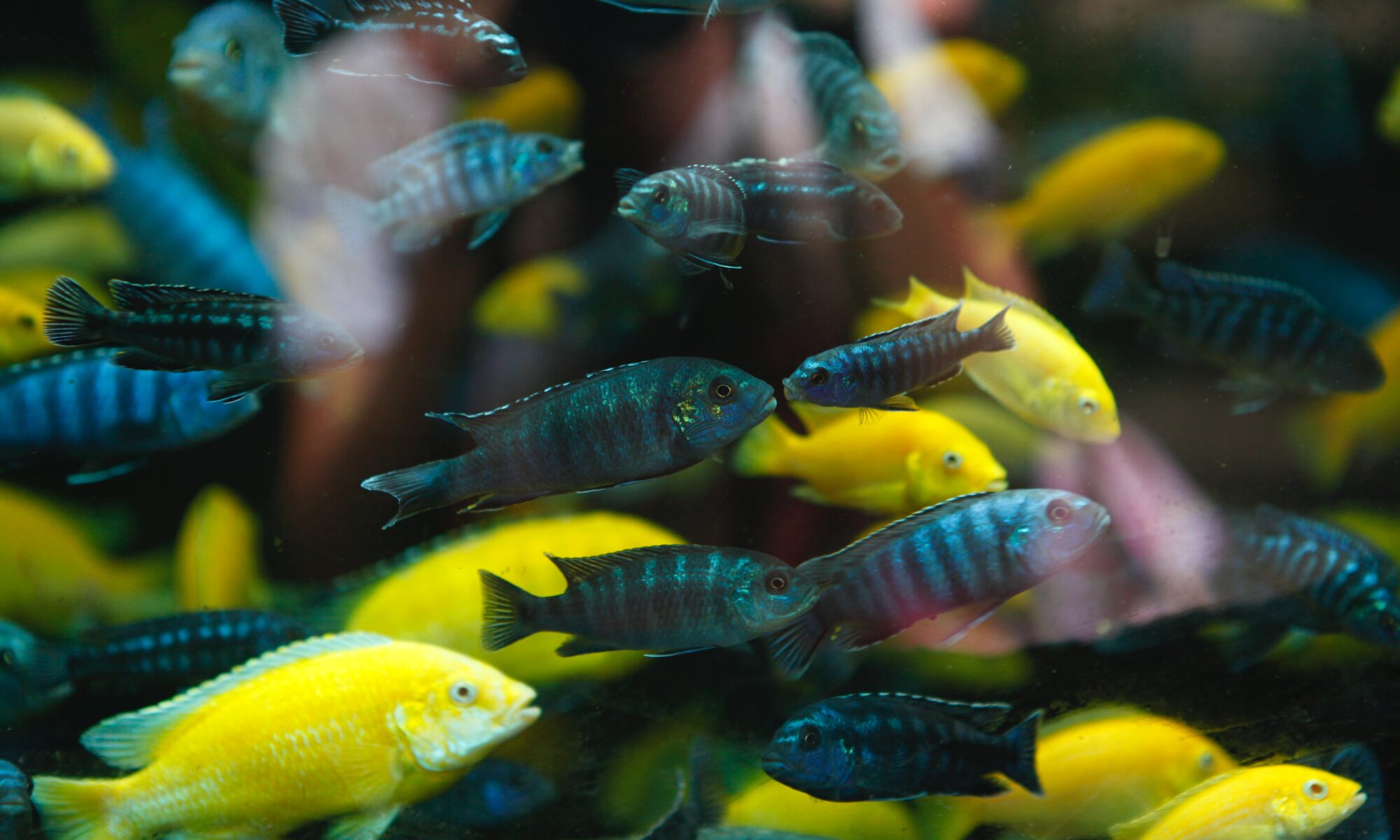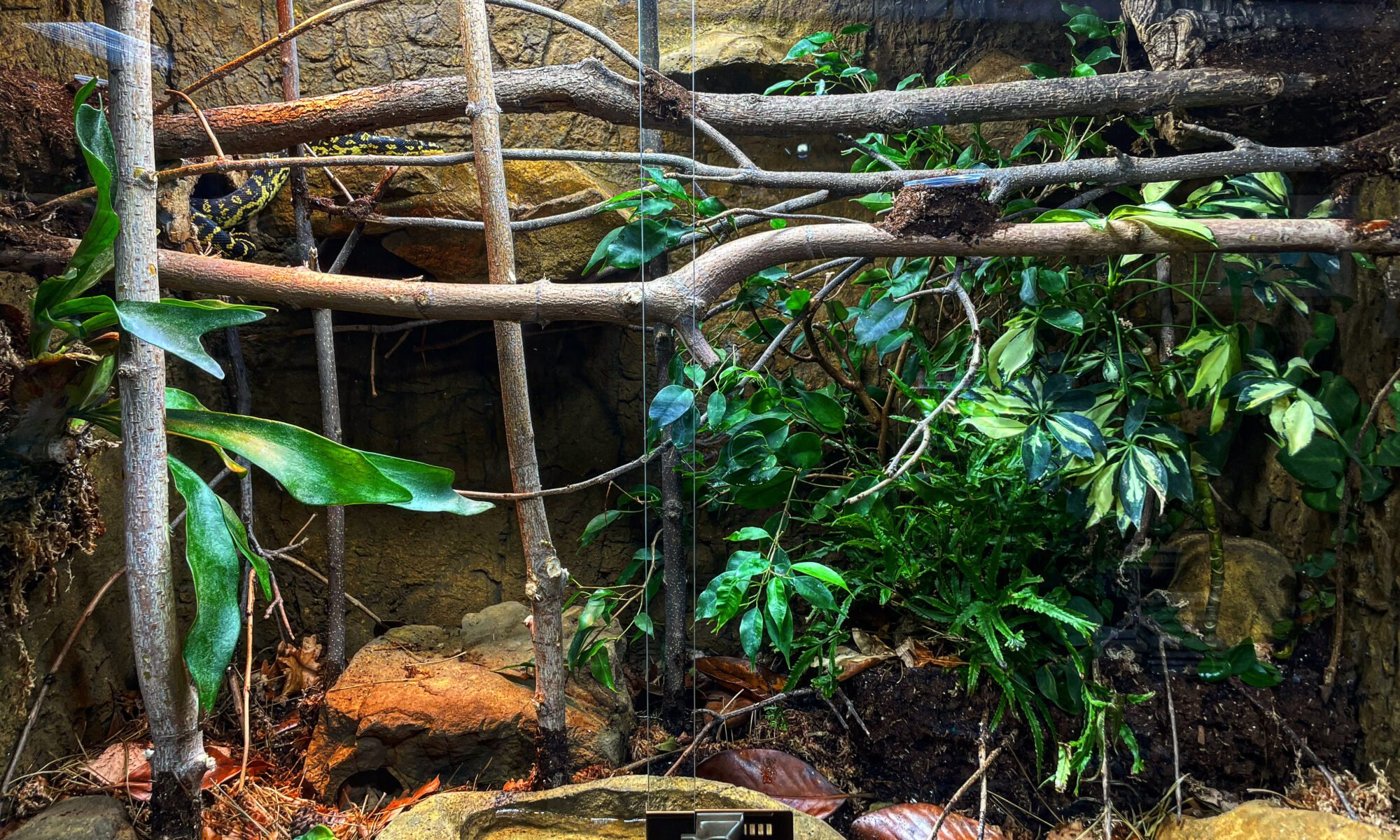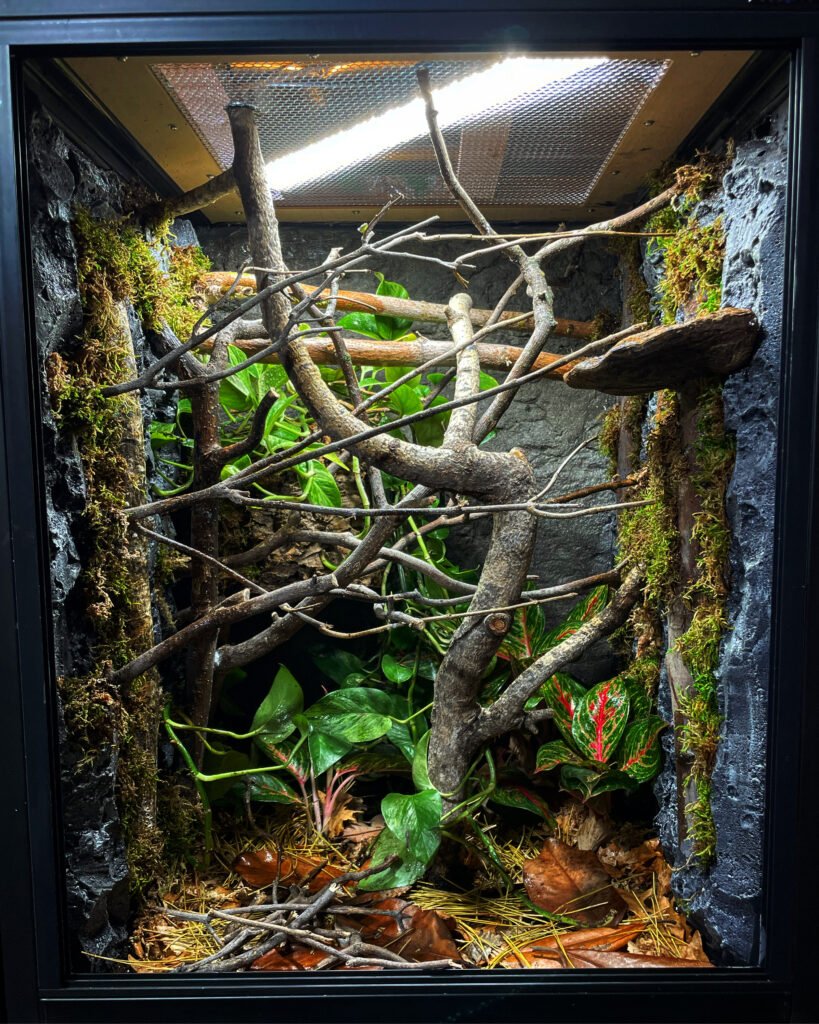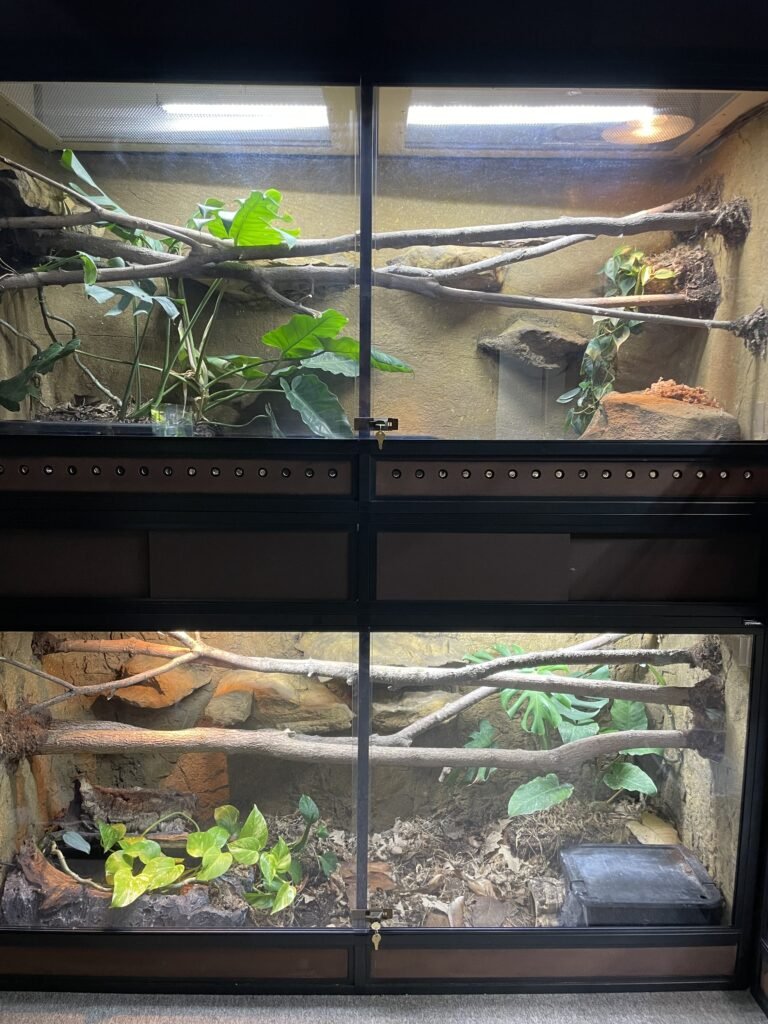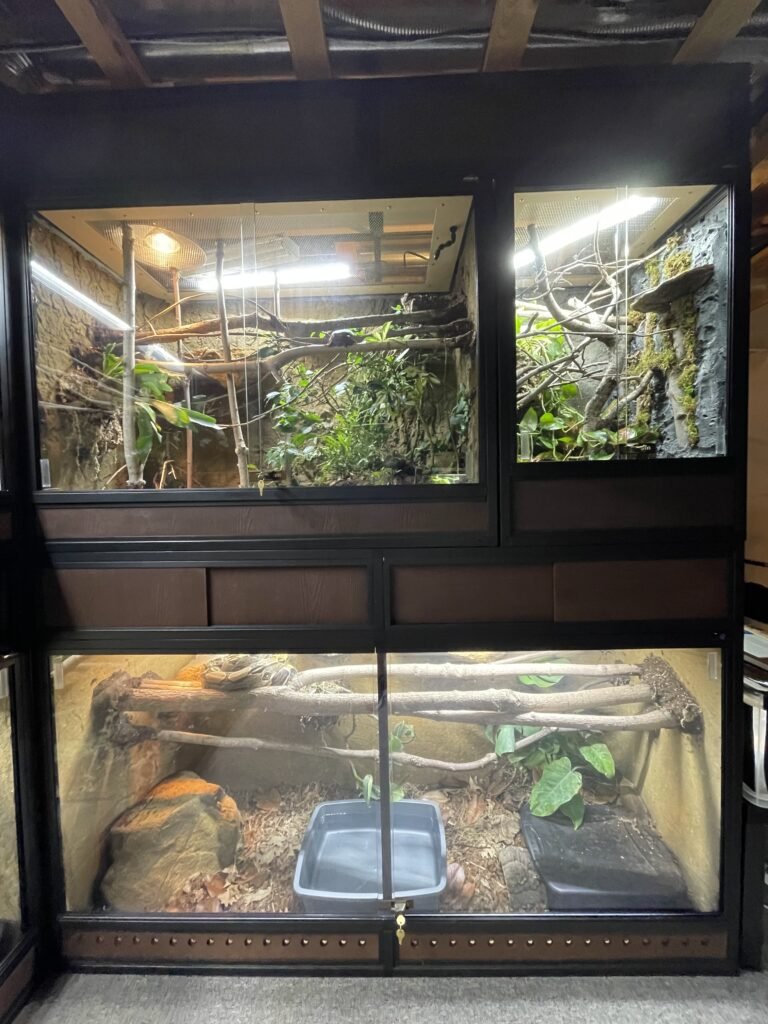By Jamie Woods
Jamie Woods is a long-time fish and reptile keeper, and a recent guest on Project: Herpetoculture HERE
Introduction
The purpose of this article is best explained by telling you, the reader, about my worst failure in aquarium keeping. As a teenager in the early 2000s, I managed to get ahold of an incredibly beautiful species of rare monster fish called Datnioides pulcher. Datnioides pulcher, also referred to as “Siamese Tiger Fish” for their incredible striping, were rare and relatively expensive ($300-$500 USD each). I purchased three large adults and kept them in a large community aquarium filled with other monster fish species. I never tried to breed them, because everyone in the hobby believed Datnioides species were impossible to breed in captivity. There were rumors then, as there are now, that some species had been captive-bred. My suspicion at the time, and still to this day, is that individuals were “creative” with the term captive bred to skirt restrictions as they became threatened by collection. Datnioides pulcher is now considered critically endangered. The fish I owned eventually passed away due to a power outage during a hurricane, and I moved on to different species.
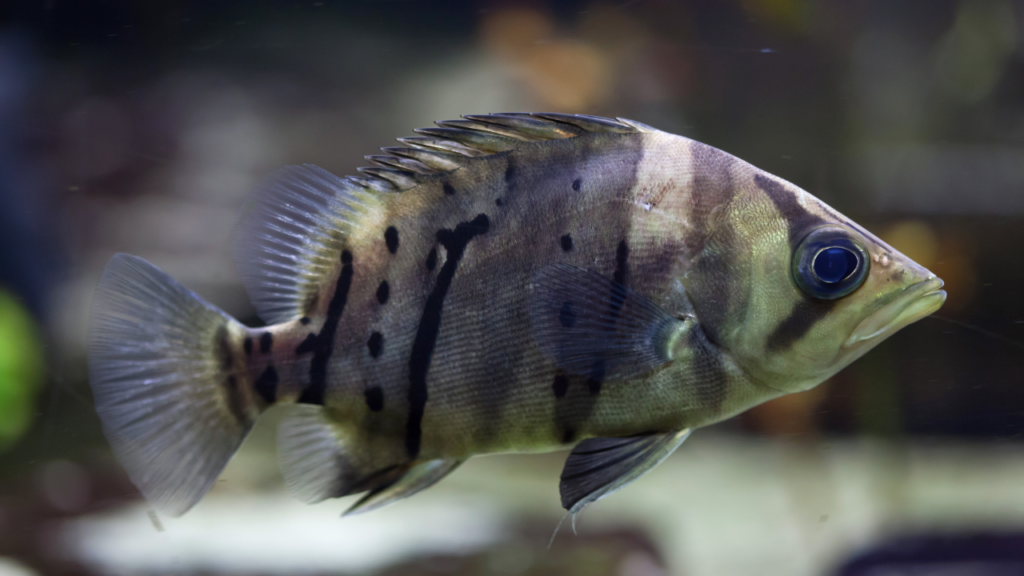
During college and graduate school, I did not have an aquarium. In 2020, I decided to begin setting up aquariums again, and I reached out to a well-known rare fish supplier to ask about Datnioides pulcher. I had not seen pictures or any for sale in years. The supplier informed me that the fish had been fished to near extinction for the aquarium hobby, or food for people who live along the fish’s Mekong River territories and that captive breeding was effectively non-existent. At that moment, it was not lost on me that I purchased and unknowingly contributed to what was likely the black-market sale of an endangered species, did not spend the time necessary to try to propagate them when I did have them, and will likely never see them again in captivity. A hobbyist who saw a picture of one now has virtually no chance of ever seeing one in person in the wild or captivity.
My goal in this article is to provide some insights and suggestions for herpetoculture from an aquarists’ perspective to continue already fruitful discussions about husbandry, breeding, care, and conservation. My hope is that through discussions, and looking to other hobbies for ideas and concepts, we as herpetoculturalists will not suffer the same fate as I did during my aquarist days. Most importantly, my hope is that the species you love, and the ones you have never heard of, will not suffer the same fate as Datnioides pulcher.
All opinions, techniques, and definitions in this article are my own unless stated otherwise. Aquarists, like herpetoculturists, do not always use the same techniques, do not always agree on their proper applications, and might have a different understanding of the topics discussed below. With that in mind, this article will delve into the aquarium hobby’s concept of bioactive or “live”, the distinction between hobbyists, hobbyist-breeders, and professional breeders, an example of a natural-history based framework used by freshwater aquarium fish breeders when a new species enters the hobby, the concept of food for the hobby, enclosure set-up, and biofeedback.
Distinction between Hobbyist, Hobbyist-Breeder, and Professionals
One of the most basic conversations that herpetoculturalists need to have is related to the different groups of individuals keeping the animals we love, and their roles in the hobby. For the aquarium hobby, the distinction between a professional breeder, hobbyist-breeder, and hobbyist, can be quite large.
I use the term “professional breeder” to describe an individual or entity that relies on the income from their breeding efforts for purposes of this article. I use the term “hobbyist-breeder”, or “small-batch breeder”, for individuals or entities that might produce to nearly the level of a professional breeder, but do not rely on the income from the hobby to live. Finally, hobbyists, though they can breed animals, are individuals whose primary activity is to keep the animals. The professional breeders in the aquarium hobby have evolved over time to meet the needs of the animals that are mass-produced for sale to the public. For the most part, the large-scale breeders are in a narrow band that runs from South-East Asia to Southern Florida. The conditions outside in these areas allow for the propagation of tropical species outdoors year-round in enormous ponds. For individuals who professionally breed specialty fish (i.e., micro-fish or fish who exhibit aggression to the point of needing separation), the use of large warehouses full of different-sized aquariums will be utilized. These aquariums generally are substrate-less and have minimal items placed in the tank. All items in the tank are there to facilitate breeding (e.g., spawning mops for species that need them, and terra cotta pots for species that breed in caves). Hobbyist-breeders at their largest generally utilize the same indoor systems as professionals, though the scale is smaller. Hobbyists, especially ones with easy-to-breed species, will see breeding success in virtually any set-up imaginable. Herpetoculture utilizes an almost identical structure to the aquarium hobby when it comes to breeding.
However, the distinction between the aquarium hobby and herpetoculture is the push-down of care standards from professional breeders of reptiles and amphibians to everyone else. The professional breeders in the aquarium hobby utilize the aquatic equivalent to small-terrarium or large rack keeping for virtually all the species bred indoors. The outdoors set-ups are the equivalent of having one large communal care enclosure. When the fish are sold to the stores, or directly to the public, the individual will be provided with the basic standard of care (temperature, PH requirement, food type, schooling or not) of the fish. I have never once, in all my dealings with suppliers or stores, ever heard a professional breeder tell an individual that they must keep the fish sold to them in the same way or else it will certainly die.
In contrast, take the average scenario in herpetoculture for one of the most owned species of snake, the ball python. It is commonplace for a breeder to tell a hobbyist to put their only ball python in a rack style enclosure. The hobbyist will be told that in the wild ball pythons are found in termite mounds, the rack provides everything the animal needs, and that purchasing a rack will allow the hobbyist to accumulate more animals with very minimal extra costs. Any sort of discussion of putting the ball python in anything but a rack was actively discouraged at a professional level, and what became a choice for professional breeders due to economy of scale then became dogma. Recently, there has been significant push-back against large-scale professional breeders for a myriad of reasons. My belief is that much of the push-back comes from hobbyists who began to understand that the captive care methods espoused by professional breeders (that they used for economy of scale) do not meet the highest standard of care that a hobbyist-breeder or hobbyist is able to provide for significantly less animals. I believe that the breakdown of communication, and the backlash that has followed, is the fault of all levels of herpetoculture. Below, I outline ways in which each level of herpetoculture could help improve it as a whole:
Professional breeders – The single most important lesson that professional breeders should learn from the aquarium hobby is that the breeder ultimately has a responsibility to make sure the animals that they produce can live most of the time in the conditions that the average purchaser of that specific species is going to keep them in. When I was working in the retail portion of the aquarium hobby, we would find that specific supplier’s animals would have an unusually large number of fatalities in our customer’s aquariums. Through numerous discussions with these suppliers, we eventually realized that they were utilizing preventative antibiotic treatments and entirely empty, sterile enclosures. This created animals that had no natural immunity to even basic pathogens, which would cause these animals to die within days of being placed in the average hobbyist’s aquarium. I stress here that these same hobbyists had perfectly acceptable water parameters and had immense success when they received fish from different suppliers.
The setup described above is analogous to the keeping of snakes in sterile racks. The animals have no immunity, no ability to resist even basic condition changes, and in many cases fail to thrive when placed in any environment other than a similarly sterile rack setup. Professional breeders, in response to consistent deaths of their animals when they are moved to the average keeper’s terrarium, blame the end hobbyist’s care. The initial care of the juvenile by the breeder has made it unable to adapt to the standard of care that an end hobbyist provides. I stress here that I am not discussing a hobbyist who sets up an animal in a way that completely deprives the animal of the conditions that they would have evolved to live in in the wild. I also stress that some species of sensitive reptiles really might only be able to be kept one way. However, it defies logic to believe that the only way to keep a reptile species would be fundamentally different than the way that they live in the wild.
The average hobbyist now readily has access to information that shows the natural history of the species they are interested in due to the internet. This has led to a disconnect between what the hobbyists read about the animal, and the only way of care that is put forward by the professional breeder. Unfortunately, this has led to attacks on professional breeders. Professional breeders, in response to the attacks on their method of keeping, have chosen to be less forthcoming with care information, instead of continuing to offer care advice. This has been perceived as confirming the allegations that their methods are inhumane, or unethical.
Instead, I propose that professional breeders rethink their methods and delivery of care advice to re-align with the expectations of the current hobby. One method might be transitioning species into larger enclosures that more accurately mimic what the average hobbyist will attempt to do. Afterwards, the professional breeder can provide detailed commentary on whether this change allowed for breeding at a professional level, or if this method is unsustainable. I suspect that these breeders will find the public is willing to pay an increased premium for animals if the animals have a better chance of success of living in the average keeper’s enclosure and will be grateful if the care advice they receive doesn’t fly in the face of all the natural history information that the hobbyist has access to.
Hobbyist-breeders- Hobbyist-breeders are in the unique position to further herpetoculture through experimentation and increased standards of care. Herpetoculturists and hobbyists must acknowledge that some species of reptiles and amphibians are unsuitable for mass production. This can be caused by difficulty with breeding, large size, abnormal conditions that are required for the animals to breed or live, or the cost of the animals. Hobbyist-breeders, who are not tied to the financial whims of the hobby, do not need to produce enough to live. This allows them to work with the species that have specific requirements, try to determine what is effective, and determine the species’ viability for captive care.
Hobbyists- Hobbyists have two main responsibilities moving forward in the hobby. First, hobbyists must learn to vote with their dollar. If a hobbyist gets poor advice from a breeder, sees poor care from the breeder, or does not otherwise believe in something the breeder is doing, then the hobbyist has a duty to give their money to someone who meets their criteria. This is the only method, other than hobby-wide legislation, that will impact professional breeders enough to change their methods. Second, and arguably most important, is that the hobbyist has a duty to research the natural history and care of the animals they are interested in. The sheer number of hobbyists (not breeders) who parrot information from a breeder to other hobbyists without fact-checking is inexcusable. Additionally, it is inexcusable to divert from the care standards the breeder tells you only to care for an animal in a way that does not align with their natural history.
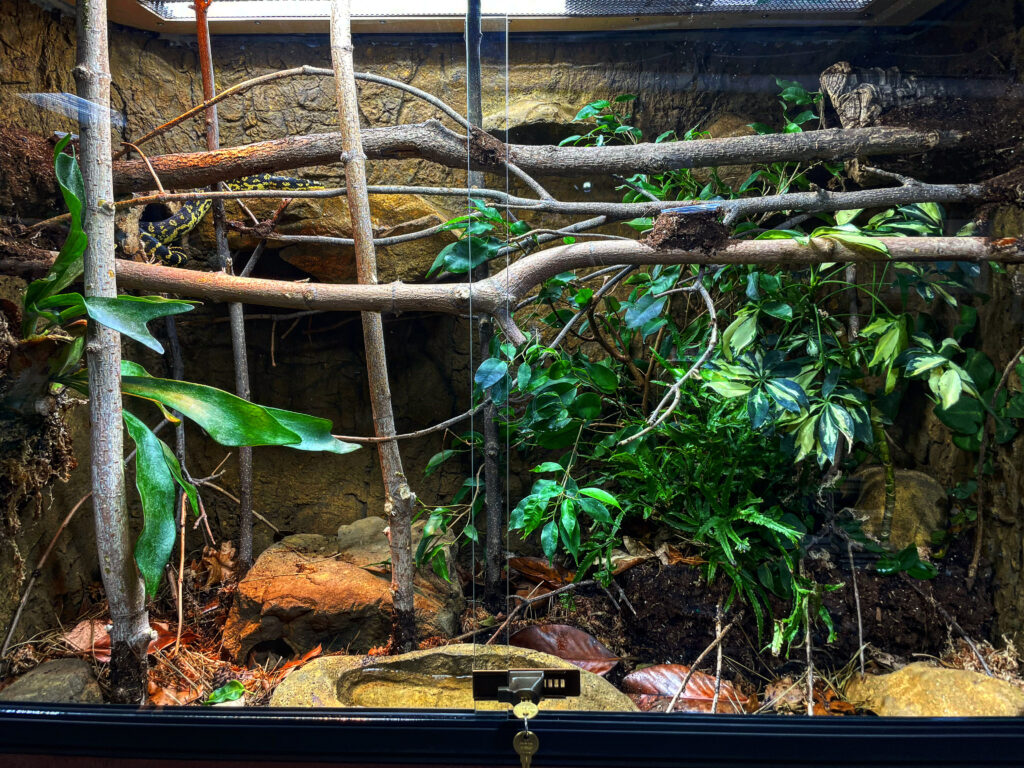
Bioactivity
One of the hot topics in herpetoculture today is the concept of bioactive enclosures. The concept appears to be amorphous; it can mean anything from a biotope (a concept discussed later in this article) to an enclosure that uses natural material but does not meet the natural history of the animal(s) kept in the enclosure. Generally, it is used to describe an enclosure that has a drainage layer under a thick layer of substrate, plants, and some sort of invertebrate life intended to help remove waste. While these type enclosures are hardly new, the dart frog community has used them for decades, the term has become diluted to the point of ineffectiveness.
Marine aquariums represent the pinnacle of “bioactivity” in an enclosed space. Everyone has seen them; you see a light dusting of sand on the bottom of the aquarium, some rock, corals and anemones, some crabs or snails busily cleaning the tank, and some fish to add movement. However, the aquarium hobby does not use the term “bioactive” in the manner used by reptile keepers, and for good reason. To understand the ineffectiveness of bioactive as a term, it is helpful to understand filtration in a marine aquarium. All filtration for aquariums generally falls into three categories; the first is mechanical filtration. This is the filter bag, or sponge that traps particulate matter as it goes through the filter. The second is chemical filtration, this is the bag of carbon that is used to remove color from aquariums and have them look crystal clear. The third, and most relevant for herpetoculture, is biological filtration. All surfaces of an aquarium act as biological filter due to the presence of microscopic bacteria that break down harmful ammonia into less harmful substances. This is generally referred to as the nitrogen process. A filter’s biological component comprises any number of highly porous media that provides a greater surface area for more of these beneficial bacteria to grow.
What marine aquarium keepers realized is that the substrate in an aquarium, and the rock, could act as the biological filtration component just as well as the filter could. The term “live rock” directly refers to rock that has been allowed to sit in an aquarium long enough to become seeded with beneficial bacteria. Live rock and live sand revolutionized marine aquarium keeping by providing a dramatic increase in beneficial bacteria, thereby increasing the bio load the aquarium could hold without accumulating harmful amounts of ammonia. Importantly, a completely man-made piece of fake rock, given enough time, will become “live” within the meaning of the marine aquarium hobby. Aquarists will also include snails and crabs and shrimp into an aquarium to help remove larger pieces of waste. This group is referred to as a clean-up crew and is separate from the bioactivity of the aquarium.
Why is this relevant for herpetoculturists communicating with each other? Because the bioactivity, the “liveness” of the aquarium, is not determined by the composition of the rock or the presence of the snails and other invertebrates that remove larger pieces of waste. Herpetoculturists could achieve a similar “live substrate” concept by using just a deep layer of potting soil. In fact, this concept is given an entire chapter in Philippe De Vosjoli’s seminal work The Art of Keeping Snakes. I propose that herpetoculture break down the idea of bioactive into facets like the marine aquarium hobby does, and acknowledge that a deep layer of substrate, managed well, is called “live”. Additionally, the inclusion of a clean-up crew (which I propose we formalize usage of the term) should be understood to have no bearing on the “liveness” of the enclosure. It is just another facet to make caretaker’s lives easier.
A correction in the terms used would negate discussion where individuals who have tied a clean-up crew to “bioactivity” are incapable of understanding how keepers who don’t believe in clean-up crews (for whatever reason) can still call their enclosures “bioactive”. I also propose that the term “naturalistic”, which will be discussed at length later, be disentangled from the concept of “bioactive”, because it is entirely possible to use an unnatural substrate to create a living ecosystem.
The Flaw of “Naturalistic” Terminology
The term “naturalistic”, similarly to the term “bioactive”, has become used so inconsistently as to have been rendered meaningless in herpetoculture. To emphasize this point, let’s go over two directly conflicting scenarios that play out daily. First are individuals keeping animals in enclosures with entirely natural (in the sense that the objects are not man-made) objects in their enclosures. While at first glance, this does not appear to be an issue, take a very common social media example; a snake is kept in an environment that is radically different from what it would find in the wild. Think desert species in a vivarium with tropical plants, wood, and a “bioactive” substrate. In this example, is this style of keeping “naturalistic”? To many, this vivarium is the image that they picture in their head of a naturalistic enclosure.
A parallel example of this phenomenon occurred in the early 2000s to present in the aquarium hobby with the introduction of the “Nature Aquarium” phenomenon. “Nature Aquarium” was a term of art utilized by Takashi Amano, who is arguably the most influential person in the aquarium hobby of the last one hundred years. Mr. Amano created the style of planted aquarium which is most common today; the tanks are bright, clear, clean, have perfectly manicured aquatic plants, and generally a species of schooling fish or two. Over time, this school has different styles (e.g., iwagumi for the rock-focused aquascapes), but the concept is the same. One aspect of the “Nature Aquarium” style, which is rarely discussed, is that the environment is entirely unnatural for a vast majority of the species utilized in them. The most common example, the cardinal tetra (Paracheirodon axelrodi) is commonly found in the Rio Negro and Rio Orinoco River systems in South America. “Rio Negro”, which means “Black River”, is just that. The water is a deep brown color. It could not be further from the bright, clear, “Nature Aquarium” that the species is commonly kept in. While the species does well in the “Nature Aquarium” set-up consistently, it does not change the fact that “Nature Aquarium” is a misnomer for this species.
The contrasting example is a desert species kept in an enclosure where the substrate is some sort of tile, and the decorations are concrete blocks, piled high towards the light source. If the average keeper was asked which was “naturalistic”, the consensus would almost certainly be the first. This is because “naturalistic”, as used in the hobby, has been divorced from “the items that fulfill the animal’s basic needs in the wild”. Again, just like in the aquarium hobby, breeders and hobbyists alike will utilize man-made items that fulfill the basic needs of the animal more effectively than the conditions present in “naturalistic” enclosures. These examples are intended to highlight how the language of herpetoculture needs to be more precise, and to not let language dictate behavior to the detriment of the animals.
Finally, the concept of a “biotope” is beginning to take hold in herpetoculture. Generally, a biotope is a closed system that seeks to mimic a specific natural system through all aspects of design and husbandry. This includes plants, animal species, substrate, and materials used. Examples in the aquarium hobby can be found at https://biotopeaquariumproject.com/. Some individuals will take a single picture of a single spot in a single stream and recreate that set-up. Others will broadly create “Rio Negro” biotopes using animals from anywhere in the river.
Biotopes, in my opinion, are the single most interesting area for herpetoculture moving forward. They can solve numerous problems at once by forcing keepers to learn about the natural history of the regions that their animals come from. This is particularly important with hard to keep species or species new to the hobby. Additionally, it can be a fun challenge to incorporate unique plant fauna or other decorations into the terrarium. Fundamentally, biotopes allow a keeper to express their understanding of the natural history of their animals in visual form.
While the preceding three topics were discussions, or critiques, of the current herpetocultural landscape, the following are ideas from the aquarium hobby that herpetoculturalists could consider experimenting with to help their work with difficult to keep animals. These ideas, while esoteric, are intended to facilitate discussion and out-of-the-box thinking.
Lack of Biofeedback in Enclosures
One of the concepts that underlies the aquarium hobby, but is not necessarily discussed consistently, is the concept of biofeedback in an enclosed space. Picture your typical aquarium; it has a school of a small tetra species moving back and forth while bottom feeders go through the substrate looking for morsels of hidden food. An algae eater is working away, and a nocturnal species is quietly sleeping inside a structure. Contrast this with a typical snake enclosure. The snake is the only living thing in the enclosure. The environment around it is completely still. Occasionally, the owner or another exceptionally large animal passes by, without any ability for the snake to sense it until the animal or human is directly upon them. To most species of reptiles, anything larger than them is first interpreted as a predator. This is especially pronounced in neonate or juvenile snakes, who are notorious for failing to thrive in large enclosures. Much of this, in my opinion, is due to a lack of biofeedback in the enclosure. One aquarium concept, called “dither fish”, I believe has potential in herpetoculture.
Broadly, dither fish are a fish species that is fast, tough, and cheaper than your focus species. If the focus species is also a predator, then the dither fish might also provide a source of food. Dither fish provide value in two distinct scenarios: for aggressive pairs and for scared fish. I will discuss them in order.
Many of the large cichlids in the aquarium hobby exhibit strong pair bonding behavior that is unfortunately offset by extreme territoriality. In the wild, the males would run off from each other during male combat, and no harm would come to either other than a bruised ego. Similarly, the female, after mating, would run the male a suitable distance away from the nesting site. In some species, this creates a two-perimeter guarding system by the pair, where the male guards an outer perimeter and the female guards the fry in a tighter perimeter. Unfortunately, in the confines of an aquarium, the pair cannot get away from each other. As a result, the male will generally beat the female to death, or vice versa depending on species.
One extremely effective method to avoid this is to introduce a large, fast moving, schooling fish into the enclosure. This provides the pair an external source to focus their aggression on, which in turn strengthens the pair-bond. This has been so effective for me in the past that once the pair-bond has been strengthened through dither fish, some pairs can live without the dither fish long term. This concept could be useful for reptiles through smaller, faster species that are introduced to help disperse intraspecies aggression in lizards. For example, some keepers of Uromastyx have discussed intense aggression between certain pairs. To strengthen this bond, while not running the risk of the Uromastyx themselves getting injured, a smaller species of desert lizard could be introduced to the enclosure. This might cause the pair to have an external source to “fight”, and lead to better pair bonding.
The second use is to help scared fish become more sociable. In my aquarium example above, the schooling species provide an indicator for all other fish in the aquarium that they will look to determine what level of threat something is to themselves. If someone has a skittish fish, the introduction of fish that are not skittish will almost always lead to the skittish fish beginning to relax. In essence, they see that the outgoing fish are not scared, and therefore they believe they have nothing to fear. This method might be of value for individuals working with skittish reptiles and amphibians or juveniles. By providing a dither species, the individual is capable of learning that the keeper is not a threat by witnessing the dither animal act normally. Of course, this only works if the dither species chosen are not skittish themselves. Additionally, for species that eat other reptile species as a food source, (e.g. small Drymarchon eating lizards), this could provide them meals at their own pace.
Food
Herpetoculture has made enormous strides in the availability of foods for animals that have more specialized feeding requirements. While the feeding of cold-blooded prey has not been taken up entirely, the creation of items like Repti-Links is promising.
One interesting aspect of feeding that is not discussed in herpetoculture, but is mentioned in the aquarium hobby, is the use of live foods to condition breeding stock. It is a well-known phenomenon in fish breeding circles that some species, which will live perfectly fine eating frozen-thawed food or processed fish food, will not breed unless offered live food. The live food can be the exact same food that is offered frozen-thawed, but will have the effect of causing mating behavior from both the males and females of a species. It is possible that there is a slight nutritional difference between the frozen-thawed prey source and the live. However, my belief is that it is the act of hunting the live food that triggers the mating behavior.
Hunting live food is fundamentally different from eating the same food frozen-thawed. The fish must react faster, utilize more energy, and the prospect of failure is there. The act of hunting, which includes utilizing their senses to find the prey, seeing (or sensing) movement, and increasing activity to do all of this, is fundamentally more natural for many fish than picking a flake off the surface of the aquarium. Additionally, the sight (or sense) of an increased abundance of live prey is normally associated with a seasonal change in the fish’s natural environment.
Contrast this with the common method of conditioning snakes. The food source never changes. Instead, feeding frequency is decreased for parts of the year, and then increased for other parts. I emphasize that this method is extremely effective and does mimic the seasonality that all reptiles go through in nature. However, this process only focuses on one part of the hunt as described above. It is possible that for some snake species (e.g., arboreal and ground nest-raiders), that the abundance of food is a secondary breeding trigger to the act of hunting itself.
Framework (Or Lack Thereof) For Breeding New Species Brought into The Hobby
One of the notable aspects of the aquarium hobby is the understanding that fish from the same area, regardless of how closely they are related, will be under very similar environmental pressures. This concept is deceivingly simple, and particularly valuable, for breeding new species of fish in captivity. Below is an example of a framework that has worked for me in breeding dozens of species of fish from the Amazon region.
The first step is to understand that the seasonal rains in the Amazon produce periods of enormous increase or decrease in the size of many of the river and drainage systems in the area. It is common for many areas to experience a gradual decrease (receding) of water into very small, isolated, pools of water. The fish here are competing for dwindling resources, the water quality is getting worse, and death is common. Food has become scarce, and the water is warming. Then, the rains come.
With the rains, the rivers and pools will flood upwards of six feet or more. Areas where food has been inaccessible are now underwater. The water is clear, cool, rainwater. Many fish, like discus, will eat foods like seeds or fruit that they couldn’t reach. Bugs and insects that did not move fast enough are now within mouth’s reach. Many species will spawn within this time and will gorge themselves on food to fatten up for mating, or to replenish themselves after laying eggs. The Amazon, underwater, is truly feast or famine.
For an aquarium hobbyist, this presents a baseline method for all species of Amazonian fish in the hobby. The method is simple. For roughly a month to three months, you slowly let the water level in the aquarium drop by evaporation. During this process water quality must be monitored to make sure it does not reach dangerous levels. You then gradually warm the water as the water level decreases. After a set period, you then add slightly cooler water to the aquarium, and immediately feed live foods (as discussed above, live foods are always the most effective tool for conditioning breeding stock). This method has worked for me for cichlids, catfish, killifish, and tetras. Additionally, because this near-exact seasonality is found in southeast Asia and parts of Africa, this method is remarkably effective with bettas, rasboras, gouramis, and others. This method does not work for all species, but the benefit of a framework is establishing the exceptions as efficiently as establishing the species who work within the framework.
The standout breeders in herpetoculture have recognized this baseline approach and have employed a structural framework. Throughout the world, aquarium hobbyists use this method as a baseline for breeding new species in the hobby. By providing a baseline, it is possible to understand exceptions to this framework better, determine a species’ viability for the hobby, and allow new breeders to undertake breeding in an already predetermined way. The reptile hobby has been slow to adopt a framework approach, and even slower to share this approach with others. The method whereby herpetoculturalists employ a framework and share it must be employed if information is going to trickle down to new keepers. It is all too common that one individual was “the guy” for a group, only to have his knowledge lost when they leave the hobby. This has created a cyclical nature to knowledge in herpetoculture and made establishing new species unnecessarily difficult.
Conclusion
My hope is, regardless of whether the reader agrees or disagrees with the points made in this article, that they will learn that expanding their areas of interest into herpetoculture-adjacent hobbies can provide new ideas, processes, and clarification. Whether your adjacent hobby becomes aquaculture, mariculture, aquaponics, horticulture, or one of the myriads of other “ultures”, the goal should always be to make yourself a more complete keeper. We have a responsibility to the animals that we care for, and my hope is that open discussion will make this responsibility easier.
